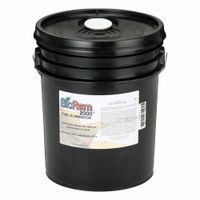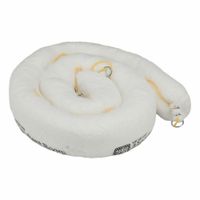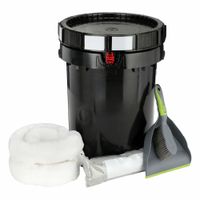Call +(254) 703 030 000 / 751 483 999 / 721 704 777
- Home
- Safety
- Sorbents Spill Control Spill Containment
- Sorbents Spill Kits
- Fuel Flammable Liquid Sorbents Spill Kits
.....Read More
Frequently Asked Questions
What are the components of a fuel and flammable liquid spill kit?
A fuel and flammable liquid spill kit typically includes the following components:
1. **Absorbent Pads and Rolls**: These are used to soak up spills quickly. They are often made of polypropylene and are designed to absorb hydrocarbons while repelling water.
2. **Absorbent Socks and Booms**: These are flexible tubes filled with absorbent material, used to contain and control the spread of spills, especially around the perimeter of the spill area.
3. **Absorbent Pillows**: These are used for larger spills and can absorb a significant amount of liquid. They are ideal for placing under leaking machinery or containers.
4. **Disposal Bags and Ties**: These are used for the safe disposal of used absorbents and contaminated materials. They are typically heavy-duty and labeled for hazardous waste.
5. **Personal Protective Equipment (PPE)**: This includes gloves, goggles, and coveralls to protect the responder from exposure to hazardous materials.
6. **Spill Containment Barriers**: These are used to prevent the spread of the spill to other areas, especially near drains or water sources.
7. **Drain Covers or Seals**: These are used to block drains and prevent spills from entering the water system.
8. **Instruction Manual or Spill Response Guide**: This provides step-by-step instructions on how to safely and effectively respond to a spill.
9. **Labels and Markers**: These are used to mark the spill area and warn others of the hazard.
10. **Broom and Dustpan**: These are used for cleaning up solidified spills or absorbent materials.
11. **Emergency Contact Information**: A list of emergency contacts and procedures for reporting spills to authorities.
These components are designed to ensure a quick, efficient, and safe response to fuel and flammable liquid spills, minimizing environmental impact and health risks.
How do fuel and flammable liquid sorbent pads work?
Fuel and flammable liquid sorbent pads work by absorbing and containing spills of hydrocarbons and other flammable liquids. These pads are typically made from polypropylene, a material that is oleophilic (oil-attracting) and hydrophobic (water-repelling). This allows them to selectively absorb oils and fuels while repelling water, making them ideal for use in environments where both oil and water are present.
The structure of the sorbent pads includes a network of fibers that create a large surface area, enhancing their absorption capacity. When a spill occurs, the liquid is drawn into the pad through capillary action. The fibers trap the liquid within the pad, preventing it from spreading further. This containment helps reduce the risk of fire and environmental contamination.
Sorbent pads are available in various thicknesses and sizes to suit different spill scenarios. They can be used in industrial settings, workshops, and marine environments. Once saturated, the pads can be disposed of according to local regulations, often through incineration or hazardous waste disposal methods.
In summary, fuel and flammable liquid sorbent pads are effective tools for managing spills by absorbing and containing hazardous liquids, thereby minimizing safety risks and environmental impact.
What is the difference between sorbent pads and sorbent socks?
Sorbent pads and sorbent socks are both tools used for spill control and cleanup, but they differ in form, application, and specific use cases.
Sorbent Pads:
- **Form**: Flat, rectangular or square sheets.
- **Material**: Typically made from polypropylene or other absorbent materials.
- **Application**: Used to cover larger surface areas to absorb spills quickly. Ideal for wiping down surfaces or placing under machinery to catch drips.
- **Absorption Capacity**: Varies, but generally designed to absorb a significant amount of liquid relative to their size.
- **Use Cases**: Effective for cleaning up spills on floors, workbenches, or any flat surfaces. Commonly used in workshops, garages, and industrial settings.
Sorbent Socks:
- **Form**: Long, tubular shape, resembling a sock.
- **Material**: Also made from polypropylene or similar absorbent materials, often with a fabric casing.
- **Application**: Used to contain and control the spread of spills. They can be placed around the perimeter of a spill to prevent it from spreading further.
- **Absorption Capacity**: Designed to absorb liquids along their length, but typically hold less liquid per unit area compared to pads.
- **Use Cases**: Ideal for encircling spills, wrapping around leaky equipment, or placing at doorways to prevent liquid from seeping into other areas. Commonly used in industrial and environmental settings for spill containment.
In summary, sorbent pads are best for absorbing spills over large areas, while sorbent socks are suited for containing and controlling the spread of spills. Both are essential components of spill response kits, each serving distinct roles in managing liquid spills effectively.
How do fuel-eating microbes break down oil products?
Fuel-eating microbes, also known as hydrocarbon-degrading microorganisms, break down oil products through a process called biodegradation. These microbes include bacteria, fungi, and archaea, which possess enzymes capable of degrading hydrocarbons, the primary components of oil.
The process begins with the microbes detecting the presence of hydrocarbons. They then attach to the oil droplets, secreting biosurfactants to increase the oil's surface area and make it more accessible. The microbes produce specific enzymes, such as oxygenases, which introduce oxygen into the hydrocarbon molecules, initiating the breakdown process.
The initial step involves the conversion of hydrocarbons into alcohols through oxidation. These alcohols are further oxidized into aldehydes and then into fatty acids. The fatty acids undergo beta-oxidation, a metabolic process that breaks them down into acetyl-CoA units. These units enter the tricarboxylic acid (TCA) cycle, also known as the Krebs cycle, where they are further metabolized to produce energy, carbon dioxide, and water.
Throughout this process, the microbes utilize the energy released for growth and reproduction, while the byproducts, primarily carbon dioxide and water, are released into the environment. The efficiency of biodegradation depends on several factors, including the type of oil, environmental conditions (such as temperature, pH, and oxygen availability), and the presence of nutrients like nitrogen and phosphorus.
Overall, these microbes play a crucial role in natural oil spill remediation by converting harmful hydrocarbons into less toxic substances, thus reducing environmental pollution and aiding in ecosystem recovery.
What are the best practices for using loose and granular sorbents?
1. **Selection**: Choose the appropriate sorbent based on the type of liquid to be absorbed (oil, water, chemicals). Consider the sorbent's absorption capacity, compatibility, and environmental impact.
2. **Application**: Apply the sorbent evenly over the spill area. For large spills, start from the perimeter and work towards the center to prevent spreading.
3. **Containment**: Use barriers or booms to contain the spill and prevent it from spreading, especially in outdoor or water environments.
4. **Layering**: For thick spills, apply sorbents in layers, allowing each layer to absorb before adding more. This maximizes efficiency and reduces waste.
5. **Monitoring**: Regularly check the saturation level of the sorbent. Replace or add more as needed to ensure complete absorption.
6. **Safety**: Wear appropriate personal protective equipment (PPE) such as gloves, masks, and goggles to protect against hazardous materials.
7. **Disposal**: Follow local regulations for the disposal of used sorbents. They may be classified as hazardous waste depending on the absorbed material.
8. **Storage**: Store sorbents in a dry, accessible location to ensure they are ready for immediate use in case of a spill.
9. **Training**: Ensure all personnel are trained in spill response procedures and the proper use of sorbents.
10. **Documentation**: Keep records of spill incidents, including the type and amount of sorbent used, to improve future response strategies.
11. **Environmental Considerations**: Opt for biodegradable or reusable sorbents when possible to minimize environmental impact.
12. **Evaluation**: After cleanup, evaluate the effectiveness of the sorbent and the response process to identify areas for improvement.
How should flammable liquid spills be disposed of after cleanup?
Flammable liquid spills should be disposed of following these steps:
1. **Absorbent Material**: Use appropriate absorbent materials like sand, vermiculite, or commercial spill kits to soak up the liquid. Ensure the absorbent is compatible with the spilled liquid.
2. **Containment**: Place the used absorbent material in a suitable, labeled container. Use metal or plastic containers that are compatible with the chemical properties of the flammable liquid.
3. **Labeling**: Clearly label the container with the type of waste, including the name of the flammable liquid and any hazards associated with it. Include the date of the spill and cleanup.
4. **Storage**: Store the waste container in a designated hazardous waste storage area. Ensure the area is well-ventilated, away from ignition sources, and compliant with local regulations.
5. **Documentation**: Maintain records of the spill, including the type and quantity of liquid, the cleanup process, and disposal method. This documentation is crucial for regulatory compliance.
6. **Disposal**: Contact a licensed hazardous waste disposal company to handle the final disposal. They will ensure the waste is treated, recycled, or disposed of according to local, state, and federal regulations.
7. **Regulatory Compliance**: Follow all relevant regulations, such as OSHA, EPA, and local environmental laws, to ensure proper handling and disposal of hazardous waste.
8. **Training and Preparedness**: Ensure all personnel involved in the cleanup and disposal process are trained in handling hazardous materials and emergency response procedures.
9. **Review and Improve**: After disposal, review the incident to improve future spill response and prevention strategies.
By following these steps, you ensure the safe and compliant disposal of flammable liquid spills, minimizing environmental impact and health risks.
What safety precautions should be taken when handling flammable liquid spill kits?
When handling flammable liquid spill kits, several safety precautions should be observed:
1. **Personal Protective Equipment (PPE):** Wear appropriate PPE, including gloves, goggles, and flame-resistant clothing, to protect against skin and eye contact.
2. **Ventilation:** Ensure the area is well-ventilated to prevent the accumulation of flammable vapors, which can lead to fire or explosion.
3. **Ignition Sources:** Eliminate all potential ignition sources, such as open flames, sparks, and electrical equipment, from the vicinity of the spill.
4. **Spill Containment:** Use absorbent materials from the spill kit to contain and control the spread of the liquid. Create a barrier around the spill to prevent it from reaching drains or other sensitive areas.
5. **Proper Disposal:** Dispose of used absorbents and contaminated materials in accordance with local regulations. Use designated containers for flammable waste to prevent accidental ignition.
6. **Emergency Equipment:** Have fire extinguishers and other emergency equipment readily available in case of a fire. Ensure all personnel are trained in their use.
7. **Communication:** Inform all personnel in the area about the spill and the actions being taken. Use signage or barriers to restrict access to the affected area.
8. **Training:** Ensure all personnel handling spill kits are trained in their proper use and understand the risks associated with flammable liquids.
9. **Documentation:** Record the incident, including the type and quantity of liquid spilled, actions taken, and any injuries or exposures.
10. **Review and Update Procedures:** After the incident, review the response to identify any areas for improvement and update procedures as necessary.
By following these precautions, the risks associated with handling flammable liquid spills can be significantly reduced.



